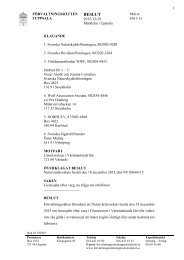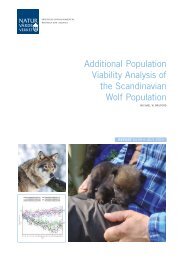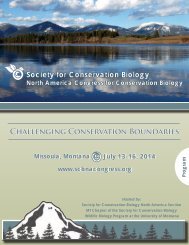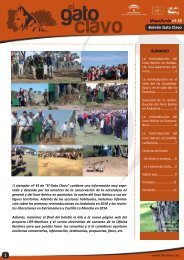1oC3Dbk
1oC3Dbk
1oC3Dbk
You also want an ePaper? Increase the reach of your titles
YUMPU automatically turns print PDFs into web optimized ePapers that Google loves.
the Management Effectiveness Tracking Tool (METT) to<br />
biodiversity outcomes, examining the management elements<br />
that result in positive biodiversity outcomes.<br />
• The Task Force has partnered with a new group of marine<br />
scientists with funding under the SESYNC program (National<br />
Socio-Environmental Synthesis Centre) at the University of<br />
Maryland. We held two global meetings in 2013 to develop a<br />
model of effectiveness of marine protected areas. The<br />
SESYNC group has become a part of the Task Force and we<br />
are aiming at producing results in time for the World Parks<br />
Congress.<br />
• The Task Force is working with the evaluation units of the<br />
Global Environmental Facility and the United Nations<br />
Development Program. We were funded to assist with an<br />
initial analysis of the effectiveness of GEF/UNDF supported<br />
protected areas in conserving biodiversity. We are currently<br />
negotiating a significantly larger analysis of projects.<br />
Objective 2 links directly to Species Strategic Plan Target 16:<br />
Setting global standards for the identification of sites of<br />
biodiversity conservation significance. Following the<br />
recommendations from the Framing workshop in Cambridge<br />
last year, we organized several technical workshops and<br />
regional consultations this year:<br />
• The Criteria and Delineation workshop (March 2013, Front<br />
Royal, USA) defined the criteria of the new Key Biodiversity<br />
Area (KBA) standard and agreed on key considerations for<br />
delineating KBAs.<br />
• Interviews were conducted with various stakeholders and<br />
end-users (e.g. donors, NGOs, Indigenous people, local<br />
communities) on their needs and potential use of the KBA<br />
methodology.<br />
• A Joint Marine Working Group was created with the Global<br />
Ocean Biodiversity Initiative (GOBI) to strengthen synergies<br />
between the identification of Ecologically and Biologically<br />
Significant Areas (EBSAs) and the KBA process. A workshop<br />
was held during the International Marine Protected Areas<br />
Congress 3 (October 2013, Marseilles) to discuss how KBAs<br />
could provide a list of potential sites to be considered for<br />
EBSAs adopted by the Convention on Biological Diversity.<br />
• The Governance workshop (Nov 2013, Brasilia) focused on<br />
the governance mechanisms of the new KBA standard, in<br />
particular the role of the different stakeholders, relationships<br />
between national and global processes, and process to<br />
nominate, validate and endorse KBAs.<br />
• The Thresholds workshop (Dec 2013, Rome) established<br />
thresholds for measures of biodiversity significance, in other<br />
words, for defining how “key” a site needs to be for it to be<br />
considered a “Key Biodiversity Area”.<br />
• A number of presentations and consultations were organized<br />
during existing regional meetings.<br />
Wild Pig Specialist Group<br />
The Wild Pig Specialist Group (WPSG) is concerned with the<br />
survival in the wild of all 17 presently recognized species as<br />
well as threatened subspecies of wild pig. Wild pigs play<br />
important ecological as well as socio-economic and cultural<br />
roles in many countries in Asia and Africa. Some taxa are<br />
highly threatened; especially those in Indonesia, the Philippines<br />
and India being of conservation concern.<br />
The WPSG uses a combination of strategies to try and<br />
reverse population declines. Our work includes: 1) research on<br />
taxonomy and distribution; 2) management of captive and wild<br />
populations to prevent the extinction of the most endangered<br />
species; and 3) facilitation of any conservation actions that<br />
benefit threatened wild pig populations.<br />
We have made some excellent progress in 2013; a<br />
workshop was held in Indonesia in November, which focused<br />
on the south and southeast Asian pig species, this was a great<br />
opportunity to update our conservation strategies and plan our<br />
next moves. Important decisions were made about the in-situ<br />
and ex-situ management of Javan Warty Pig (Sus verrucosus).<br />
We agreed to implement studies of the little known Bawean<br />
Pig and small island populations of babirusas, and also to<br />
address hunting and wildlife trade on Sulawesi. Furthermore,<br />
the workshop has improved the coordination between the<br />
breeding programs for Pygmy Hog, Visayan Warty Pig, and<br />
Javan Warty Pig.<br />
Further updates about our work on wild pigs can be found<br />
in the twice-yearly Suiform Soundings, the newsletter for the<br />
IUCN SSC Specialist Groups for Wild Pigs, Peccaries and<br />
Hippos. You can also find us on our website.<br />
Dr Erik Meijaard<br />
Chair, Wild Pig Specialist Group<br />
Javan Warty Pig (Sus verrucosus). © Florian Richter<br />
The results of these technical workshops will be integrated into a<br />
draft methodology available for comment, before publication<br />
and launch in November 2014 at the World Parks Congress.<br />
The Joint Task Force on Biodiversity and Protected Areas<br />
would like to thank Environment Agency Abu Dhabi, Cambridge<br />
Conservation Fund, MAVA Foundation, John D. and Catherine T.<br />
MacArthur Foundation, Ministério do Meio Ambiente do Brasil,<br />
Rio Tinto and Shell.<br />
Penny Langhammer and Stephen Woodley<br />
Co-chairs, WCPA/SSC Joint Task Force on Biodiversity and<br />
Protected Areas<br />
92 IUCN species Annual Report 2013






